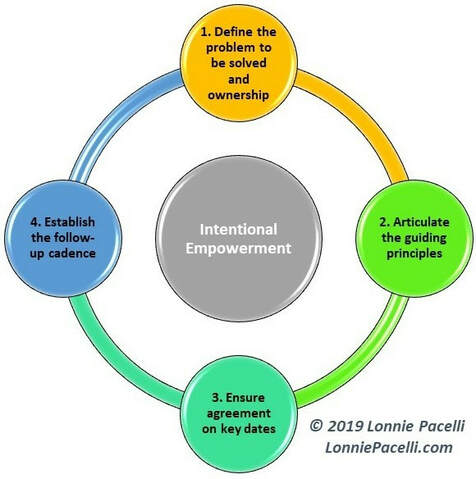
Empowerment.
One of the most over-used, warmed-over leadership terms uttered daily. Leaders high and low espouse their expertise in empowering teams to deliver. Some are very good at it, fostering high-performance teams who deliver great results. Others, though, only think they are good at it but frustrate teams with micromanagement, apathy, vagueness, and randomization. Most anyone who has been around the block has seen both good and bad empowerment examples. As for me, I’ve not only seen it, I’ve committed both the good and bad. It took me years to understand that empowerment isn’t just about delegating tasks to be performed. True empowerment is about entrusting individuals with problems to be solved and supporting them in the process. A high-performance empowered team owns problems or missions and is supported by a leader who provides clarity, gives guidance, and resolves only those issues the team can’t resolve on their own. To put some meat on this, I like to think of empowerment as systematic, with four critical steps needed to ensure its success. I call this intentional empowerment. 
Step 1 – Define the problem to be solved and ownership
The first step in intentional empowerment is the clear articulation of a problem statement. The size of the problem doesn’t matter, it can be something that will take hours, days, or months to solve. What matters is a clear understanding of the problem statement, as well as ownership of the problem statement and the resulting solution. Here is a good example:
Step 2 – Articulate the guiding principles Articulating guiding principles is about policy, legal, regulatory, or other guidelines which the solution needs to adhere to. Note this is not about telling the problem owner how to do something, it’s about ensuring the problem owner knows the boundaries that he or she needs to abide by in solving the problem. Some good examples of guiding principles:
And a couple of bad examples:
Guiding principles aren’t about controlling how something gets done, they are about the problem owner knowing what latitude he or she has in solution definition. Step 3 – Ensure agreement on key dates Knowing when something needs to be done and any key interim milestone dates enables the problem owner to figure out tasks and resourcing needs to hit the dates. It’s crucial here to get crisp on a specific date, not an “ASAP,” “immediately,” or “yesterday” date. It’s important for the leader to have his or her key dates thought out to ensure alignment with the problem owner. A good example:
And bad ones:
It may be that a problem needs to be resolved urgently; if that’s the case then stress the urgency to the problem owner but put a date on it. Don’t leave the when up to interpretation. Step 4 – Establish the follow-up cadence Key to intentional empowerment is an agreed-upon and timely follow-up cadence that both the leader and problem owner understand and agree is appropriate. When done well, the leader and problem owner stay aligned on execution and can fulfill project “asks” on a timely basis. It also minimizes surprises and frantic rework when expectations aren’t met. Just as importantly, though, is the leader staying in his or her lane by serving as a resource for the problem owner. An impatient or meddling leader can start micro-managing or dictating how something should be done. The problem owner turns into errand runner, with the leader hijacking problem ownership. Empowerment gone bad. The cadence frequency should be appropriate to the problem and its due date, whether it be monthly, weekly, daily, hourly, or some other increment. As a leader it’s important to work on the frequency right-sizing with the problem owner; too infrequent can communicate disinterest, too frequent can communicate distrust. Here is an example for a project with a due date of one month:
For the same project here are a couple of bad examples:
There’s no one-size-fits-all follow-up cadence, what’s important is that the cadence exists, and both the leader and problem owner agree it’s appropriate. Again, too-infrequent follow-up communicates disinterest, while too-frequent follow-up communicates distrust. I want to leave you with one last thought. Empowerment is a privilege, not a right. Those who are empowered have to earn and keep the trust of their manager, peers, and employees. Ensure when you are empowering someone to solve a problem that you are doing so because you trust him/her, and that if the trust is breached the willingness to empower diminishes. With that being said, take the time to understand intentional empowerment and use it to create high-performance teams that deliver value to your organization. See what Rosa Parks, Abraham Lincoln, Napoleon Bonaparte, Harriet Tubman, and Susan B. Anthony have to say about intentional empowerment in Behind Gold Doors: Five Legends Offer the Keys to Empowering Leadership.
Lonnie Pacelli
Keynote Speaker | Board Director | Autism Advocate | Author | Project Management Expert | Microsoft/Accenture Veteran See his books on Amazon.
0 Comments
Leave a Reply. |
Topics
All
Reprints
Contact Lonnie about article reprints. Please specify article you wish to reprint. Backlist
See Lonnie's Amazon Author Page Archives
July 2024
|
Lonnie Pacelli - Building Thriving Leaders™
Insightful | Creative | Direct Advice to Help Leaders Help Themselves
Keynote Speaker | Board Director | Autism Advocate | Author | Project Management Expert | Microsoft/Accenture Veteran
See his books on Amazon
Insightful | Creative | Direct Advice to Help Leaders Help Themselves
Keynote Speaker | Board Director | Autism Advocate | Author | Project Management Expert | Microsoft/Accenture Veteran
See his books on Amazon
Services |
About
|
© COPYRIGHT 2019. ALL RIGHTS RESERVED.
We are a participant in the Amazon Services LLC Associates Program, an affiliate advertising program designed to provide a means for us to earn fees by linking to Amazon.com and affiliated sites.
|

 RSS Feed
RSS Feed